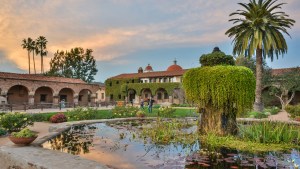Saying “the Bible says this” or “the Bible says that” about any given subject is a thorny, delicate business. To begin with, there isn’t just one Bible —there are plenty of translations, some excellent, some almost completely unreliable. But there are also literally different Bibles. Jews have one, Protestant Christians have another, and Orthodox Christians and Roman Catholics have yet another one — the biggest of them all, containing 73 books in total. Needless to say, all of these Bibles are intimately related to one another, and regularly overlap. But they are not entirely the same. In fact, these traditions have different hermeneutical, interpretive attitudes toward the same texts, drawing singular lessons from them.
The process of deciding which texts end up being included in any of these Bibles is called canonization. The Jewish canon is often referred to as “Tanakh.” The word is an acronym made of the first letters of each of the three main collections included in it: “T” for the Torah (the first five books), “N” for Nevi’im (meaning “prophets,” which include not only the books with prophets’ names as their titles, but also the historical books of Joshua, Judges, Samuel, and Kings), and “K” for Kethuvim (meaning “writings,” which includes more or less everything else). This is the collection Christians refer to as the Old Testament. But what does canonization has to do with traveling and pilgrimages?
The Book of Genesis, the first book of this “Old Testament,” includes a story that is central to Christian ideas of pilgrimage: that of the expulsion of Adam and Eve from Eden, as told in Genesis 3. In the text, we find God “driving out” (Cf. Gn 3, 22, 24) the original couple from the Garden after they eat from the Tree of Knowledge of Good and Evil. Christian traditions have read these texts as understanding human beings (Adam and Eve’s descendants) are but exiles in a harsh and often inhospitable world, estranged both from God and from one another by sin. Later narratives in the same book of Genesis highlight this being exiled as a constitutive attribute of human existence: when Adam and Eve’s eldest son, Cain, murders his brother Abel in a fit of jealous anger (Cf. Gn 4, 1-16) he is sent into further exile, away from his home and family.
The way back from said exile has been understood as related to pilgrimaging.
Exiles and pilgrims, since Abraham
Exile is constant all throughout the Old Testament. Hebrews are more often than not strangers in strange lands — Egypt, the desert, Babylon. In fact, both exile and pilgrimage share core common traits. More often than not, the many different journeys from and into exile we find in Scripture are themselves “pilgrimages” with rich spiritual meaning. Both Abraham’s journey from Ur to Canaan and the story of the exodus from Egypt present God as journeying with his people.
The moment Abraham leaves his home in Mesopotamia (Cf. Gn 12, 1-9) to go in search of a land which God promises to show him, he becomes a “pilgrim” who willingly goes into exile. It is this readiness to obey God and venture into the unknown what makes him the quintessential man of faith. Something similar occurs when, in the exodus from Egypt, the Israelites travel through the wilderness to the very same Abrahamic land of Canaan. Through their journey, they experience both hardship and God’s care and guidance.
This “exodic” motif plays such a key role in Christian thought that Luke’s Gospel (Cf Lk 9, 28-36) uses the exact same word (“exodus”) to refer to Jesus’ death and resurrection. In the Transfiguration, we find Jesus, Moses, and Elijah speaking about Jesus’ departure,“which he was about to bring to fulfillment at Jerusalem.” The Greek word Luke uses for “departure” in the original is exodos, in an obvious allusion to Moses’ exodus out of Egypt, and to Elijah’s “departing” from this world, entering heaven alive “in a whirlwind.” Here, the author of the Gospel is offering a clear reading of the history of salvation as going from Moses’ liberation to that offered by Jesus, and a prefiguration of Jesus’ own Ascension into Heaven alive, once resurrected. That is, the long exodic journey of the Israelites, through the desert, towards the Promised Land, was later interpreted as a model of the Christian journey through a “fallen,” estranged world, towards communion with God and others.
Scripture also explains how Jerusalem soon developed into a center of pilgrimage — the Temple being the place where God could be encountered in a very unique way. Pilgrimage to Jerusalem on the three main feasts of the year (Pesaj, Shavuot, and Sukkot) became mandatory for all male Israelites, who would often have been joined by their families. Even more so, during exilic periods, pilgrimage to Jerusalem took on additional emotional, national, and spiritual significance.
Pilgrimage in the New Testament
The Gospels pick up most of these distinctive Hebrew themes. But they introduce several important changes in how these motifs are to be interpreted. The expulsion from Paradise and all the following stories of estrangement, exile, and conflict constitute the setting of what the New Testament recognizes as the long drama of redemption — the focus shifts from seeking God in Jerusalem to finding him in Christ. Early biblical commentators thus developed a complex web of typological connections and allegorical interpretations giving characters and events from the Hebrew Bible a radically new significance according to the teachings of the New Testament.
In general, New Testament writers stress the essential transience of this world (Cf Jn 2, 17; 1 Cor 7,31; or James 1:11) therefore encouraging believers to understand themselves as “pilgrims and strangers on the earth” or “temporary residents” whose true home is to be found in heaven (1 Peter 2:11; Hebrews 11:13). Moreover, Christian life itself is conceived as a journey towards that homeland.
Christian pilgrimage was first made to sites associated with the birth, life, crucifixion and resurrection of Jesus. Testimonies date back as early as the 3rd century — it is known that Origen traveled from Egypt to Palestine, and then from Palestine to Athens, visiting sites tradition already held as “holy.” There are also plenty of surviving descriptions of Christian pilgrimages to the Holy Land dated from the 4th century, when this practice was encouraged by Church fathers.
Perhaps the best summary of Christian pilgrimage was given by Pope Benedict XVI when he himself visited Santiago de Compostela in 2010:
“To go on pilgrimage is not simply to visit a place to admire its treasures of nature, art or history. To go on pilgrimage really means to step out of ourselves in order to encounter God where he has revealed himself, where his grace has shone with particular splendour and produced rich fruits of conversion and holiness among those who believe. Above all, Christians go on pilgrimage to the Holy Land, to the places associated with the Lord’s passion, death and resurrection. They go to Rome, the city of the martyrdom of Peter and Paul, and also to Compostela, which, associated with the memory of Saint James, has welcomed pilgrims from throughout the world who desire to strengthen their spirit with the Apostle’s witness of faith and love.”




